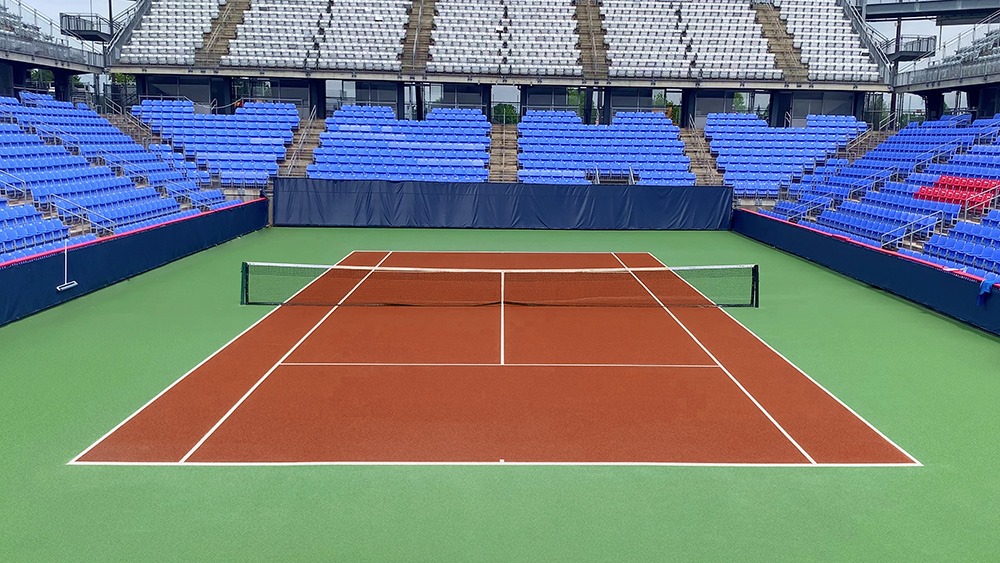
Elite stadium of Tennis Court Construction
Tennis Court Construction involves several key steps to ensure the final product meets the necessary specifications for a safe and functional playing surface. Here’s an overview of the ABCs of tennis court construction:
Step 1-Site Selection and Preparation:
-
- Choose a suitable location with adequate space, proper drainage, and good soil conditions.
- Clear the site of any obstacles, rocks, or vegetation.
- Ensure proper grading to facilitate water drainage away from the court.
- Ideally, orient the court in a north-south direction to minimize the impact of the sun on gameplay. This helps avoid issues such as glare when serving or looking towards the sun.
- Choose a site with good natural drainage or plan for an effective drainage system. Proper drainage is essential to prevent waterlogging and ensure a dry playing surface.
- Assess the soil conditions to ensure stability and proper drainage. Avoid sites with excessive clay content or poor drainage, as these can lead to uneven surfaces and surface damage.
- Select a flat and level area to simplify construction and reduce the need for extensive grading. If the site has a slope, it may require additional earthwork to create a level playing surface.
- Site 2-Layout and Dimensions:
-
- Mark the court dimensions according to official regulations (78 feet in length and 27 feet in width for a singles court, 36 feet in width for a doubles court).
- Verify the correct angles and distances for the service lines, baseline, and center service line.
- Step 3-Excavation:
- Excavate the marked area to the required depth, typically around 12 inches.
- Use heavy machinery such as excavators or backhoes to perform the initial excavation. Remove the top layer of soil to expose the underlying subsoil.
- Excavate to the required depth, which is typically around 12 inches for the sub-base. Verify the depth regularly using a laser level or other surveying tools.
- Remove any excess soil and debris, ensuring a smooth and level surface.
- Step 4-Sub-base Installation:
- Install a stable sub-base to provide support and prevent settling.
- Common sub-base materials include crushed stone or gravel, compacted to achieve the desired firmness.
- Step 5-Drainage System:
- Install an efficient drainage system to prevent water accumulation on the court.
- Use perforated pipes and a layer of gravel to facilitate proper water drainage
Step 6-Fencing and Surrounding Area:
- Erect a sturdy perimeter fence around the court to contain balls and provide security.
- Consider the installation of windbreaks and screening for privacy.
Step 7-Surface Material:
-
- Choose a suitable playing surface based on player preferences, climate, and budget. The best option for tennis court material is synthetic court material. Synthetic court materials, such as acrylic or polyurethane surfaces, are known for their durability.
- They can withstand heavy use, resist cracking, and require less maintenance compared to some natural surfaces like clay. Synthetic courts are accessible year-round, even in areas with extreme weather conditions. This ensures a more consistent playing schedule and availability for players.
- Tennis Court Manufacturers like Pacecourt allows for customization based on player preferences and the desired pace of play.
- While initial installation costs may vary, synthetic court surfaces can be cost-effective over the long term due to lower maintenance requirements and extended lifespan compared to some natural surfaces.
- Synthetic courts generally require less maintenance than natural surfaces. They are easier to clean, and their sealed nature makes them less susceptible to weed growth, mold, and other issues.
Step-8 Line Marking:
- Mark the court lines according to official regulations using durable and weather-resistant paint.
- Verify accuracy in measurements for baselines, service lines, center service line, and other markings.
Step 7-Net and Posts Installation:
- Set up a regulation net and posts at the center of the court.
- Ensure proper tension in the net, and verify the correct height at the center strap.
Step-8 Final Inspection and Maintenance Guidelines:
- Inspect the entire construction for any irregularities or issues.
- Provide maintenance guidelines to the owner, including recommendations for regular cleaning, repairs, and surface recoating.
Always consult with a professional court construction company, like Pacecourt to ensure compliance with local regulations and standards.
Why is Pacecourt the leading tennis court manufacturer?
There are several reasons why someone might choose Pacecourt for their sports flooring needs, depending on their specific priorities and situation. Here are some of the key points to consider:
Product quality and performance:
- High-quality materials: Pacecourt uses materials designed for durability and performance, with options suitable for various sports and activities. They claim their surfaces adhere to international quality standards for specific sports like basketball and tennis.
- Safety: Their surfaces are designed to be slip-resistant and provide good shock absorption, which can help reduce the risk of injuries.
- Customization: They offer a variety of colors and configurations to customize your court to your preferences.
Company reputation and service:
- Experience: Pacecourt has been in the business for some time and has experience installing courts for various clients.
- Project advisory and execution: They offer a team of experts to help you with the design, planning, and execution of your project.
- Warranty: They offer a warranty on their products, providing some peace of mind for customers.
Affordability:
- Pacecourt claims to offer competitive prices and discounts for their products and services.
However, it’s important to remember that these are just some of the reasons why someone might choose Pacecourt.
By carefully considering all of these factors, you can make an informed decision about whether Pacecourt is the right choice for you.
